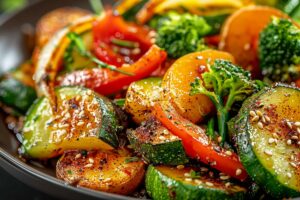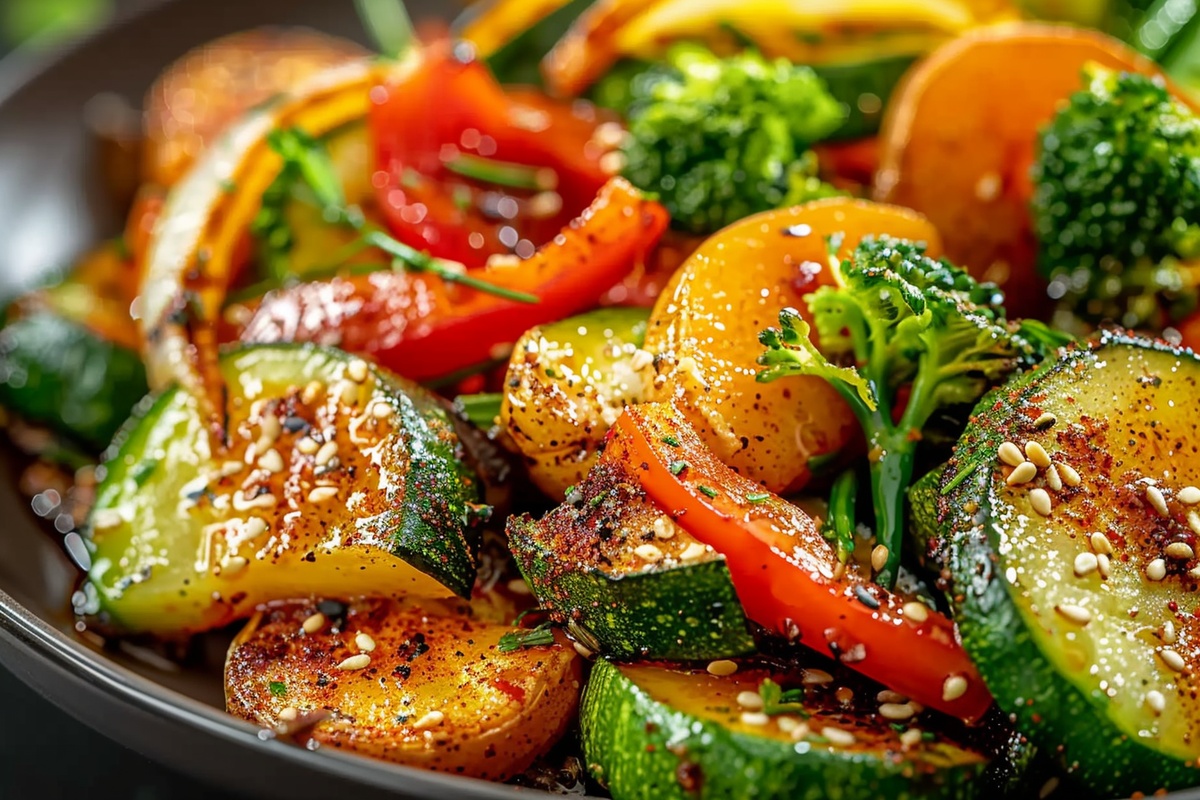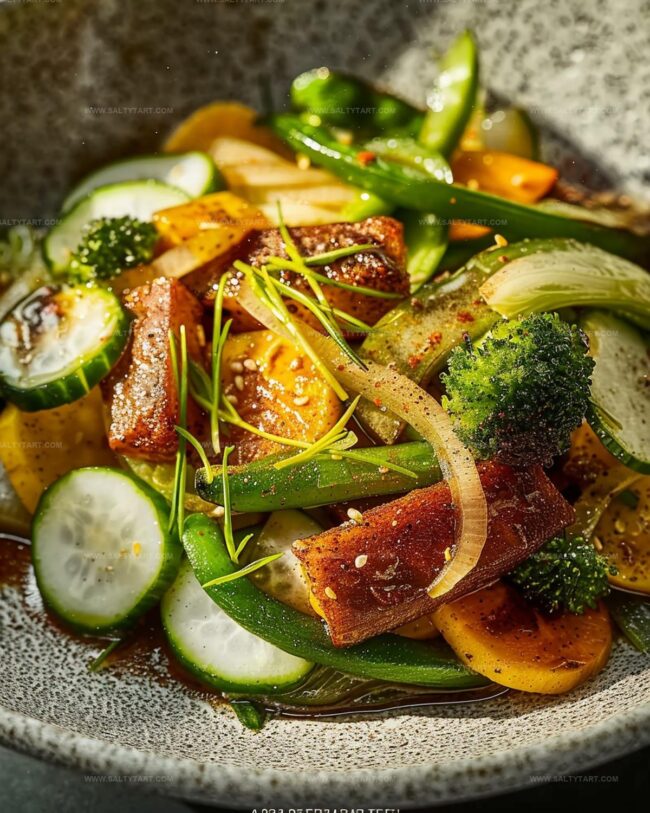Quick & Colorful Hibachi Vegetables Recipe for Tasty Homemade Joy
Crafting a delectable hibachi vegetables dish brings joy to any home kitchen adventure.
Sizzling colors and vibrant flavors dance across your cutting board with each precise chop.
Japanese-inspired cooking techniques transform simple ingredients into a remarkable culinary experience.
Crisp zucchini, bright bell peppers, and tender onions create a symphony of textures that delight the senses.
Fresh ingredients marry together through quick, high-heat preparation methods that seal in natural goodness.
Authentic restaurant-style magic happens when you understand the subtle art of vegetable seasoning and precise timing.
This recipe promises to transport you straight to a classic hibachi grill with minimal effort and maximum flavor.
Storing Hibachi Vegetables for Meal Prep
FAQs
Hibachi-style vegetables are quickly cooked over high heat to create a slightly charred exterior while maintaining a crisp texture, using minimal seasoning to enhance the natural vegetable flavors.
Fresh vegetables are recommended for the best texture and flavor, as frozen vegetables tend to release more water and can become mushy during cooking.
Yes, this hibachi vegetable recipe is completely vegetarian and can be easily adapted to various dietary preferences by adjusting the type of vegetables used.
Cook the vegetables over high heat, don’t overcrowd the pan, and avoid stirring too frequently to allow proper caramelization and maintain a crisp texture.
Why Hibachi Vegetables Add Sizzle to Any Meal
Ingredients for Flavorful Hibachi Vegetables
Main Vegetables:Aromatics:Seasoning and Oils:Cooking Ingredient:Steps for Sautéing Hibachi Vegetables at Home
Step 1: Fire Up the Cooking Surface
Grab a large skillet or wok and drizzle vegetable oil across the bottom. Crank the heat to medium-high and let the oil get sizzling hot.
Step 2: Slice and Prepare Colorful Vegetables
Chop your fresh vegetables into similar-sized pieces:Step 3: Toss Vegetables into the Hot Pan
Drop all the chopped vegetables into the skillet in one swift motion. Listen for that delightful sizzling sound that signals perfect cooking.
Step 4: Create Golden Edges
Stir and flip the vegetables continuously for 5-7 minutes. Watch as they transform with beautiful caramelized edges and start to soften slightly.
Step 5: Boost the Flavor Profile
Sprinkle minced garlic into the pan and stir quickly. The aroma will instantly fill your kitchen with an incredible fragrance.
Step 6: Season and Glaze
Pour in soy sauce and sesame oil. Toss everything together so each vegetable gets coated in the delicious sauce.
Sprinkle salt and black pepper to enhance the taste.
Step 7: Final Sizzle
Cook for an additional 2-3 minutes until vegetables reach your desired tenderness.
Remove from heat and serve immediately while piping hot.
Tips for Crispy and Colorful Hibachi Veggies
Hibachi Vegetable Swaps and Additions
Pairings for a Hibachi Vegetable Plate
Choose a crisp, chilled Japanese sake to complement the umami-rich hibachi vegetables, balancing the savory soy sauce and bringing out the subtle vegetable flavors.
Brew a light green tea that cuts through the oily skillet notes and provides a clean, refreshing counterpoint to the warm, caramelized vegetables.
Serve alongside grilled chicken teriyaki or seared tofu to transform this side dish into a complete, protein-packed meal with harmonious Asian-inspired flavors.
Sprinkle toasted sesame seeds or chopped green onions on top to add a nutty, fresh dimension that elevates the texture and visual appeal of the hibachi vegetables.
Print
Hibachi Vegetables Recipe
- Total Time: 20 minutes
- Yield: 4 1x
Description
Sizzling hibachi vegetables bring Japanese steakhouse magic right to home kitchens, offering a quick and flavorful side dish packed with crisp textures. Ginger-garlic seasoned zucchini, onions, and mushrooms create restaurant-quality excitement you can easily master in minutes.
Ingredients
Main Vegetables:
- 1 medium zucchini, sliced
- 1 medium bell pepper, sliced
- 1 cup mushrooms, sliced
- 1 small onion, sliced
Seasonings and Oils:
- 2 tablespoons vegetable oil
- 2 tablespoons soy sauce
- 1 tablespoon sesame oil
- 2 cloves garlic, minced
- Salt to taste
- Pepper to taste
Instructions
- Fire up a spacious skillet or wok with vegetable oil over robust medium-high temperature.
- Tumble zucchini, bell peppers, onions, and mushrooms into the hot cooking surface, creating an aromatic medley.
- Aggressively stir-fry these vibrant vegetables for 5-7 minutes, allowing them to transform with golden edges and tender texture.
- Introduce minced garlic, releasing its intense fragrance and infusing the mixture with deep, complex notes.
- Drizzle soy sauce and sesame oil across the sizzling vegetables, thoroughly mixing to ensure every morsel absorbs the rich, umami-packed seasoning.
- Sprinkle salt and pepper, tailoring the flavor profile to your preference, and continue cooking for an additional 2-3 minutes until vegetables reach optimal tenderness.
- Transfer immediately to serving dish, presenting a colorful, steaming side that promises robust flavor and delightful texture.
Notes
- Quickly chop vegetables into uniform bite-sized pieces to ensure even cooking and professional-looking presentation.
- Control heat carefully to prevent burning while maintaining crisp vegetable texture and developing delicious caramelization.
- Customize vegetable mix based on seasonal availability or personal preference, keeping similar cooking times for consistent results.
- For gluten-free option, replace traditional soy sauce with tamari or coconut aminos to maintain authentic flavor profile.
- Prep Time: 10 minutes
- Cook Time: 10 minutes
- Category: Lunch, Dinner, Appetizer, Snacks
- Method: Sautéing
- Cuisine: Japanese
Nutrition
- Serving Size: 4
- Calories: 116 kcal
- Sugar: 3 g
- Sodium: 750 mg
- Fat: 11 g
- Saturated Fat: 1.5 g
- Unsaturated Fat: 8.5 g
- Trans Fat: 0 g
- Carbohydrates: 7 g
- Fiber: 2.5 g
- Protein: 2 g
- Cholesterol: 0 mg



Jess Martinez
Contributing Recipe Writer & Nutrition Consultant
Expertise
Southwestern and Latin American cooking, Nutritional analysis and healthy recipe planning, Cultural food traditions, Modifying traditional dishes for better health
Education
Santa Fe Community College
Certificate in Culinary Arts
Focused on mastering the flavors and cooking methods of traditional Southwestern cuisine.
Jess’s love for bold, homegrown flavors led her straight into the world of Southwestern cooking and cultural nutrition.
After completing her Certificate in Culinary Arts at Santa Fe Community College, she made it her mission to show that good-for-you food can still taste incredible.
At saltytart.com, Jess shares vibrant, health-conscious recipes with roots in tradition but a fresh, modern twist. When she’s not testing new recipes, you’ll find her at local growers’ markets, tending her herb garden, or digging into food history books.